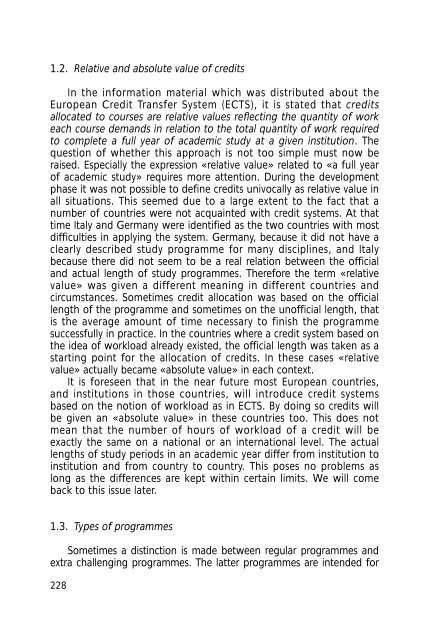Final Report Pilot Project - Relaciones Internacionales de la ...
Final Report Pilot Project - Relaciones Internacionales de la ...
Final Report Pilot Project - Relaciones Internacionales de la ...
Create successful ePaper yourself
Turn your PDF publications into a flip-book with our unique Google optimized e-Paper software.
1.2. Re<strong>la</strong>tive and absolute value of credits<br />
In the information material which was distributed about the<br />
European Credit Transfer System (ECTS), it is stated that credits<br />
allocated to courses are re<strong>la</strong>tive values reflecting the quantity of work<br />
each course <strong>de</strong>mands in re<strong>la</strong>tion to the total quantity of work required<br />
to complete a full year of aca<strong>de</strong>mic study at a given institution. The<br />
question of whether this approach is not too simple must now be<br />
raised. Especially the expression «re<strong>la</strong>tive value» re<strong>la</strong>ted to «a full year<br />
of aca<strong>de</strong>mic study» requires more attention. During the <strong>de</strong>velopment<br />
phase it was not possible to <strong>de</strong>fine credits univocally as re<strong>la</strong>tive value in<br />
all situations. This seemed due to a <strong>la</strong>rge extent to the fact that a<br />
number of countries were not acquainted with credit systems. At that<br />
time Italy and Germany were i<strong>de</strong>ntified as the two countries with most<br />
difficulties in applying the system. Germany, because it did not have a<br />
clearly <strong>de</strong>scribed study programme for many disciplines, and Italy<br />
because there did not seem to be a real re<strong>la</strong>tion between the official<br />
and actual length of study programmes. Therefore the term «re<strong>la</strong>tive<br />
value» was given a different meaning in different countries and<br />
circumstances. Sometimes credit allocation was based on the official<br />
length of the programme and sometimes on the unofficial length, that<br />
is the average amount of time necessary to finish the programme<br />
successfully in practice. In the countries where a credit system based on<br />
the i<strong>de</strong>a of workload already existed, the official length was taken as a<br />
starting point for the allocation of credits. In these cases «re<strong>la</strong>tive<br />
value» actually became «absolute value» in each context.<br />
It is foreseen that in the near future most European countries,<br />
and institutions in those countries, will introduce credit systems<br />
based on the notion of workload as in ECTS. By doing so credits will<br />
be given an «absolute value» in these countries too. This does not<br />
mean that the number of hours of workload of a credit will be<br />
exactly the same on a national or an international level. The actual<br />
lengths of study periods in an aca<strong>de</strong>mic year differ from institution to<br />
institution and from country to country. This poses no problems as<br />
long as the differences are kept within certain limits. We will come<br />
back to this issue <strong>la</strong>ter.<br />
1.3. Types of programmes<br />
Sometimes a distinction is ma<strong>de</strong> between regu<strong>la</strong>r programmes and<br />
extra challenging programmes. The <strong>la</strong>tter programmes are inten<strong>de</strong>d for<br />
228


